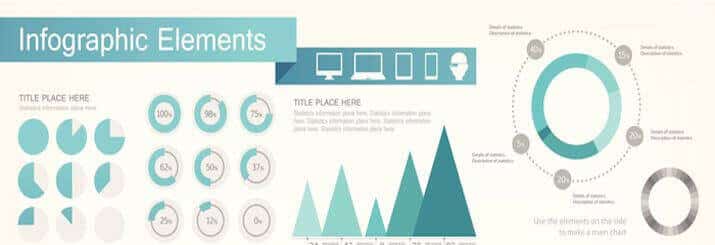People—consumers, employees, small business owners—don’t absorb information the way they used to. If the message you want to convey isn’t concise, visually appealing and easy to comprehend, it’s not going to get through.
That’s why infographics—also known as information graphics or data visualization—are having such a notable impact on the ways businesses communicate to their target audiences. The best infographics offer an eye-catching combination of text and imagery that communicates an idea more quickly, and with far greater reader comprehension, than any 20-page white paper or case study. They are the perfect information vehicle for our attention-bombarded times.
Reading itself has changed, especially online where we spend most of our time. Pages filled with text and statistics are seen as too confusing and time-consuming to wade through. We’ve become flesh-and-blood scanners of information, skimming words on a screen for the content we need and then moving on.
By adding bright colors, images and other design elements, an infographic represents data in ways that meet our hard-wired needs for both visual appeal and storytelling. Complex information is distilled down to key takeaways (precisely what consumers are looking for online) and connections between apparently different ideas become much clearer than anything in plain text.
Businesses recognizing this appeal are creating infographics to communicate across a broad spectrum of topics. Rather than rely on mere text, they’re using infographics to:
- Describe product features and benefits to customers
- Outline marketing strategies to clients
- Explain complex policies and procedures to employees
- Illustrate strategic goals to potential investors
- Share expert content and establish themselves as thought leaders in industry
Dry subjects like metrics and processes are instantly transformed into engaging, visually pleasing displays that synthesize key points in a format that’s both dramatic and memorable. Plain text simply can’t compete.
One page of words is pretty much the same as another, but every infographic differs from every other infographic. Each is a unique blend of pie charts, graphs, colors and text. Businesses can exploit this variety to communicate a wide array of messaging, from lively explanations of concepts and research analysis to humorous interpretations of customer surveys (likes/dislikes, etc.).
The critical change (and advantage) is that infographics invite reader participation, rather than discourage it as plain text does.
Nowhere is the value of infographics more apparent than in its social media applications. Businesses share a great deal of content across their networks, but a savvy marketing agency knows that sharing plain text information gains less traction than an informative, relevant and attention-grabbing infographic. A message of six hundreds words rarely goes viral. Because they are so easily read and understood, infographics go viral all the time on blogs and Twitter, Facebook and other social networking sites. They create buzz—in the world of small business internet marketing, the most valuable currency of all.
By offering infographics that are easily understood and remembered, you continuously build brand awareness as well. A well-crafted infographic educates the target audience and enhances your credibility with both consumers and others in your industry. Credibility leads to trust (based on the expertise conveyed in your infographic) and trust leads to customers preferring your business over your competitors.



